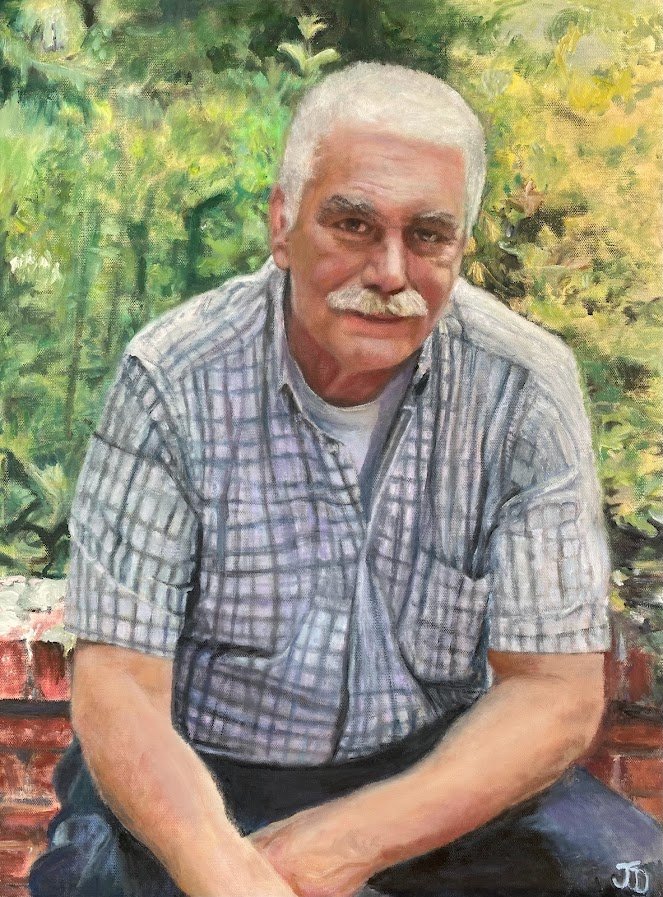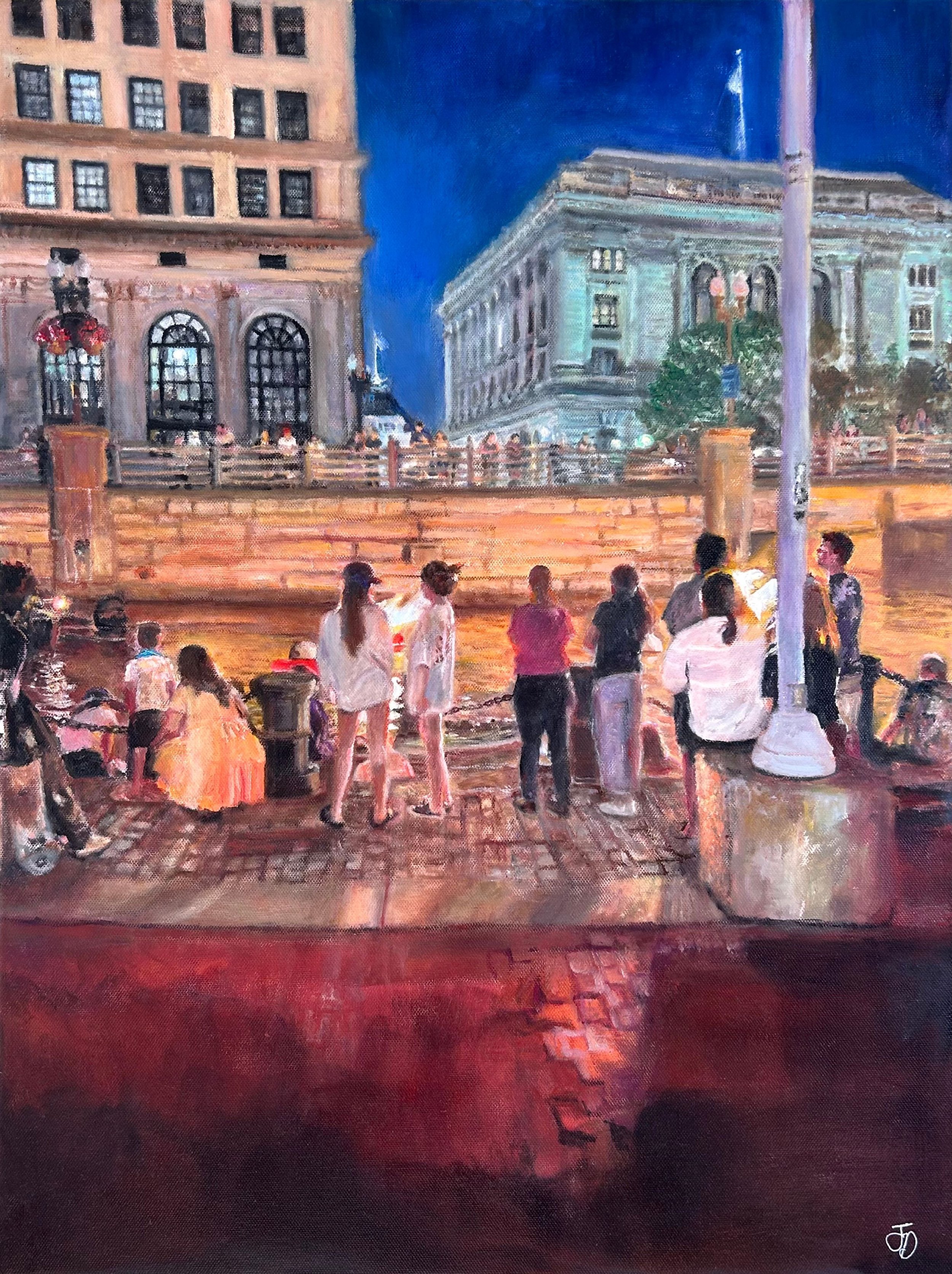Art Talk with Feature Artist Jamie Derr
This Month’s Feature artist is Jamie Derr whose Pieces are on display for March.
In discussion with us, Jamie talks about the influence of her background on her artistic lens, tips for promoting and showcasing art, and more!
In your artist bio, you indicate that your multifaceted background has aided in your ability to capture the essence of people and places in your art. Can you tell us a bit more about your background and how it's influenced your art?
I always sought to understand why humans behave the way that they do. At Wellesley College, I was able to apply some of my ideas about certain human behaviors, while conducting research in the personality field of psychology. I found many significant correlations within studies based on these observations. While my ideas were often guided by the information I had learned at school, it was my intuitive nature and insight that lead me to numerous discoveries within the field. I truly believe that these traits are largely due to my artistic abilities and intellectual curiosities. I learned to pay close attention to mannerisms and the expressions of emotions throughout my life.
As a vocalist for 20 years, I had to express myself clearly through the music of language to convey emotions, while also reading the emotions of the crowd. While navigating through each piece of music, I learned to decipher between multiple expressions and utilize them as valuable feedback to become more affective to the listener.
In terms of purely aesthetic experience, I worked as a traveling free-lance make-up artist for TV, runway, weddings, and companies such as Elizabeth Arden. This gave me a hands-on experience with faces. The tactile work with skeletal structures and their unique features helped me gain technical skills. Furthermore, encountering the personalities of each individual while working with their features and expressions helped shape my understanding of capturing a person’s “essence.” I do, however, believe a person’s essence is more than just the emotions, structures and expressions of each unique face.
While working with and studying people has definitely made capturing them easier, I truly believe that the secret ingredient is my innate ability to present both people and places to the viewer in a way that makes them feel like they know the essence of the individual or place. The truth is, the “essence” is really my convincing interpretation of the subject. In the end, the viewer must trust my interpretation based on my personal background, which I believe has proven helpful.
Can you also elaborate on your inner world and how you express it in your work?
As a child, my parents were always very busy working in the back of the family bakery in Bristol, RI. I was considered too young to help, so I would spend my time sitting at a desk. Most children would become bored out of their minds, but I relished in drawing on the parchment paper (I hope it wasn’t too expensive now that I think of it). I would also frequently walk next store to the Rogers Free Library and sign myself up, at the age of 7, for many of the activities offered. One day, I brought a dress “design” I had sketched to a boutique down the other end of Hope St. The woman who had owned the shop, had been delighted to hang my pictures up on the dressing room stalls and had asked me to make more. I was so excited. I would have never considered myself less fortunate than others at home with their parents or preoccupied in daycare.
Before we had moved to Bristol, we had lived in a part of Providence that had a high crime rate. It was so bad that we were forced to move after we were robbed. The interesting thing is that what I remember from this time period isn’t the crime or anything like that, but the beauty of the tall buildings, colors of the broken glass on the streets and the bright neon lights of the city.
Many years later when I was in college, I was working on an honors project where I had written a paper empathizing with the notorious monster “Grendel” from the book Beowulf. After it was completed, the professor had remarked how he believed that I was essentially an “idealist.” I imagine that is a great word to describe the way I view things. The resilience and optimism I struggle to maintain throughout everything, bleeds through my experiences and interactions with people, music, and art. I often focus on the beauty of everything and try to get others to see it as well through my lens. It goes beyond accurately depicting a scene like a camera, with perfect proportions ─ It is finding the perfect color, brush stroke and image to reflect the way I see the world in the most ideal way I can imagine. I love to find the beauty in things that are not typically considered conventionally beautiful as well. In fact, subjects such as flowers, are boring for me to paint. It isn’t hard to make a lovely painting of a flower, but finding the beauty of an urban street building at night? That is an exciting challenge. I believe this extends to the subjects of the portraits I have painted, and how they are often satisfied, because I try to balance highlighting their best features while accurately depicting their expressions. Finding joy in things like sketching on parchment paper cramped in a small hot room in the back of a bakery and seeing the beauty of urban life as a child seem to reflect “idealism” when attempting to describe my inner world and how I express it. I argue though, that the ideals I present aren’t necessarily impractical.
Do you have any tips for artists about promoting and showcasing their work?
First of all, don’t overthink promoting anything, the only place you should be “overthinking” is when you are creating your piece. If you think too much about promoting yourself on social media or entering any competitions, you will talk yourself out of it. Just click submit and forget about it. Also, attend events and participate in groups in your local community, like The Collaborative, artist cooperatives and/or guilds like the Portsmouth Arts Guild. Always connect with other artists as well, they can be the most supportive because they understand how vulnerable it feels to put your inner world out there! You may even find opportunities to collaborate with them as well.
If there is one thing you'd like people to take away when viewing your work, what is it and why?
I want them to remember the importance and beauty of the human experience. I also want them to attempt to find the beauty in the most unlikable things. If my perspective of the world can affect anyone in a positive way, I would be satisfied, because all of my struggles might have made a difference, like a ripple in the water. In this way, I am connecting to others through my personal experiences.
How did you first learn about The Collaborative and what was your process to prepare for this opening?
I first learned about The Collaborative through social media after inquiring about galleries and organizations that were helpful to artists trying to share their work. After reaching out, I was aware that there were many other artists booked so I was excited when I was finally contacted by Sandy for a possible feature. I found everyone I had encountered throughout the initial process all the way to the event to be beyond helpful. All of my questions were answered and the whole process ran smoothly.
To prepare for the show, I wanted the work to be as cohesive as possible. This enabled me to reflect on what it was that made me who I was as an artist, which has been beneficial to my artistic journey. I came to the realization that although I will always paint multiple subjects and themes, what essentially unifies my work as a whole isn’t necessarily a signature brush stroke or repetitive subject. What will remain constant is that everything will be painted in what I consider an “ideal” state. This becomes my artistic vision or “voice” as it is said in both literature and music… to take whatever I see and make it my own, in a way others can understand and identify with. Nocturnes remind me of my childhood, so I did want to incorporate this theme and make it a pivotal part of the selection process.



